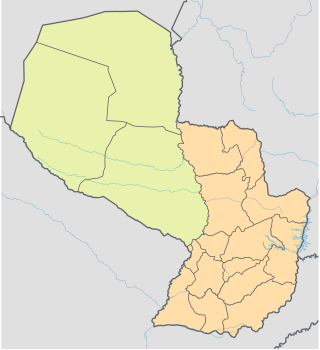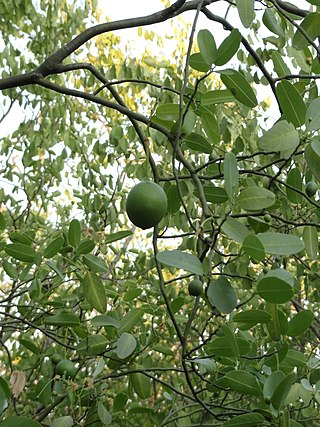
Paraguay is a country in South America, bordering Argentina, Bolivia and Brazil. The Paraguay River divides the country into strikingly different eastern and western regions. Both the eastern region and the western region gently slope toward and are drained into the Paraguay River, which separates and unifies the two regions. With the Paraneña region reaching southward and the Chaco extending to the north, Paraguay straddles the Tropic of Capricorn and experiences both subtropical and tropical climates.

Santa Cruz is the largest of the nine constituent departments of Bolivia, occupying about one-third (33.74%) of the country's territory. With an area of 370,621 km2 (143,098 sq mi), it is slightly smaller than Japan or the US state of Montana. It is located in the eastern part of the country, sharing borders in the north and east with Brazil and with Paraguay in the south.

The Gran Chaco or Dry Chaco is a sparsely populated, hot and semiarid lowland tropical dry broadleaf forest natural region of the Río de la Plata basin, divided among eastern Bolivia, western Paraguay, northern Argentina, and a portion of the Brazilian states of Mato Grosso and Mato Grosso do Sul, where it is connected with the Pantanal region. This land is sometimes called the Chaco Plain.

The Paraguayan Chaco or Región Occidental is a semi-arid region in Paraguay, with a very low population density. The area is being rapidly deforested. Consisting of more than 60% of Paraguay's land area, but with less than 3% of the population, the Chaco is one of the most sparsely inhabited areas in South America.

Cordillera is a province in the Santa Cruz Department, Bolivia. Its capital is Lagunillas.

Schinopsis lorentzii is a species of flowering plant in the family Anacardiaceae.

Bulnesia sarmientoi is a tree that inhabits a part of the Gran Chaco area in South America, around the Argentina-Bolivia-Paraguay border. Its wood is often traded as "Paraguay lignum vitae", since it has properties and uses similar to the "true" lignum vitae trees of genus Guaiacum, which are close relatives. Another trade name is "vera" or "verawood", which may also refer to the even more closely related B. arborea. Another common but rather ambiguous name is palo santo, which it shares with the species Bursera graveolens.

Schinopsis is a genus of South American trees in the family Anacardiaceae, also known by the common names quebracho, quebracho colorado and red quebracho. In Brazil it is known as baraúna or braúna.

Copernicia alba is a South American species of palm tree, which is found in the Humid Chaco ecoregion in Bolivia, Paraguay, Colombia, Brazil and Argentina. They often, but not always, form dense single-species woodlands. Its common names in Spanish show the various colours that the trunk takes according to its environment: palma blanca, palma negra, palma colorada. In Guaraní, it is called caranday, "water palm". Its English trade name is wax palm or caranday wax palm.

Aspidosperma quebracho-blanco, commonly known as Quebracho blanco, kebrako, or white quebracho, is a South American tree species, native to Brazil, northern Argentina, Bolivia, Paraguay, and Uruguay. It must not be confused with other species also known as quebracho, but belonging to the genus Schinopsis.

Prosopis kuntzei is a South American leguminous tree species that inhabits the westernmost Gran Chaco forests covering areas of Argentina, Bolivia, and Paraguay, where it acts as natural component. It has also been able to colonize the nearby pasture sabanas. It is commonly referred to as itín, palo mataco, carandá or barba de tigre. It is adapted to arid climate, but can also survive flooded ground for a long time.

Chané is the collective name for the southernmost Arawakan-speaking peoples. They lived in the plains of the northern Gran Chaco and in the foothills of the Andes in Paraguay, Brazil, Bolivia, and Argentina. The historical Chané are divided into two principal groups: the Chané proper who lived in eastern Bolivia, and the Guaná who lived in Paraguay and adjacent Brazil. Twenty-first century survivors of the Chané are the Izoceno people of Bolivia and 3,034 descendants reported in Argentina by the 2010 census. Survivors of the Guaná are the Tereno and the Kinikinao both of Mato Grosso do Sul province in Brazil.
Kaa-Iya del Gran Chaco National Park and Integrated Management Natural Area is the biggest national park in Bolivia and one of the largest in South America. It is a protected area in the region of the Gran Chaco and has a larger surface area than Belgium. It is situated in the south of Santa Cruz Department on the border with Paraguay in the Cordillera Province and Chiquitos Province.

Apuleia is a genus of flowering plants in the family Fabaceae. It belongs to the subfamily Dialioideae. The only species in the genus is Apuleia leiocarpa. It is a tree native to northern South America, from Colombia and Venezuela to Ecuador, Peru, Bolivia, Brazil, Paraguay, Uruguay, and northeastern Argentina.

Physalis viscosa is a species of flowering plant in the nightshade family known by many common names, including starhair groundcherry, stellate ground-cherry and grape groundcherry in English, and arrebenta-cavalo, balãozinho, and camambú in Portuguese and Spanish. It is native to South America, and it is known on other continents as an introduced species and sometimes a weed. It can grow in many types of habitat, including disturbed areas.

Capsicum chacoense is a species of the genus Capsicum native to South America. While it is rarely cultivated by humans, it, like domesticated Capsicum species, produces edible fruit.

Ceiba chodatii, the floss silk tree, is a species of deciduous tree native to the tropical and subtropical forests of South America. It has a bottle-shaped swollen trunk in which water is stored for the dry season and is known locally as palo borracho.

Bolivian Spanish is the variety of Spanish spoken by the majority of the population in Bolivia, either as a mother tongue or as a second language. Within the Spanish of Bolivia there are different regional varieties. In the border areas, Bolivia shares dialectal features with the neighboring countries.

Rhodocactus sacharosa, synonym Pereskia sacharosa, is a species of flowering plant in the cactus family Cactaceae, native from Bolivia and west-central Brazil to Paraguay and northern Argentina. Like all species in the genus Rhodocactus and unlike most cacti, it has persistent leaves. It was first described in 1879.

Morisonia speciosa, commonly known as bola verde, is a species of tree in the family Capparaceae. It is native to the Gran Chaco region of Bolivia, Paraguay, western Brazil, and northern Argentina. It was formerly known under the scientific names Anisocapparis speciosa and Capparis speciosa. The fruit, seeds, and flowers of Morisonia speciosa are edible. The fruit is very sweet and has a spicy flavor reminiscent of mangoes. The Toba and Wichí peoples traditionally use it both culinarily and medicinally.





















